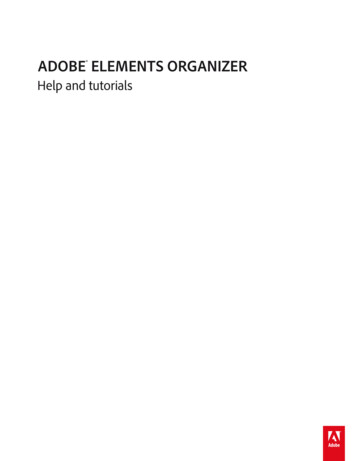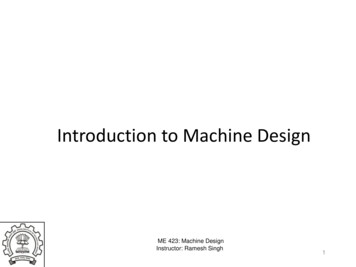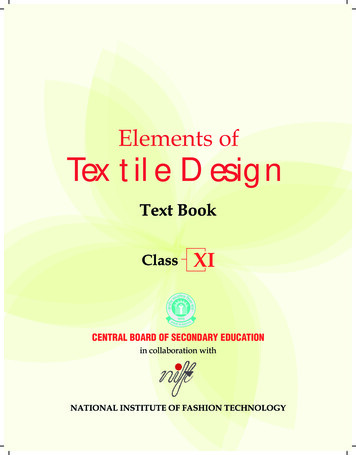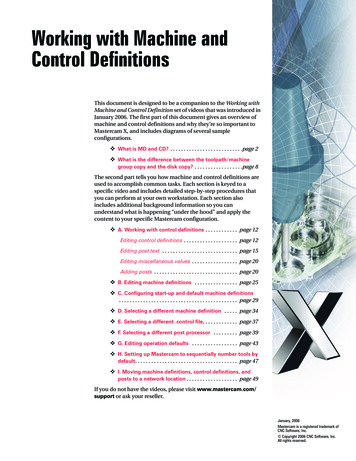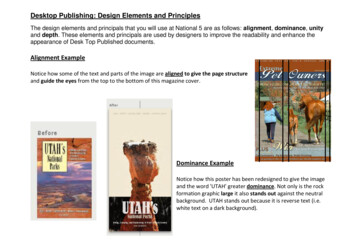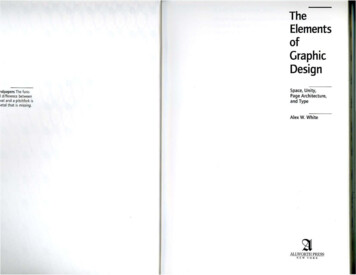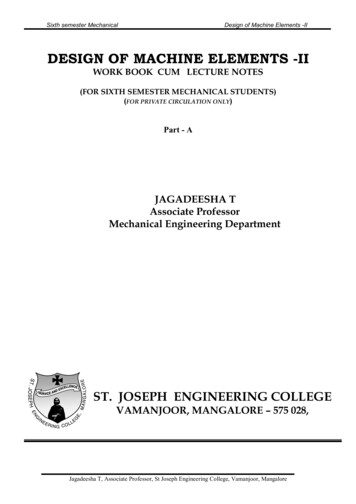
Transcription
Sixth semester MechanicalDesign of Machine Elements -IIDESIGN OF MACHINE ELEMENTS -IIWORK BOOK CUM LECTURE NOTES(FOR SIXTH SEMESTER MECHANICAL STUDENTS)(FOR PRIVATE CIRCULATION ONLY)Part - AJAGADEESHA TAssociate ProfessorMechanical Engineering DepartmentST. JOSEPH ENGINEERING COLLEGEVAMANJOOR, MANGALORE – 575 028,Jagadeesha T, Associate Professor, St Joseph Engineering College, Vamanjoor, Mangalore
Sixth semester MechanicalDesign of Machine Elements -IICHAPTER 1: CURVED BEAMSLEARNING OBJECTIVES] Introduction to curved beams] Discuss the stress distribution pattern in curved beams when compared tostraight beam with sketches] To derive the expression for the normal stress due to bending at the extremefibers of a curved beam] To design curved beams for different cross sections] To study and design stresses in closed rings.Curved BeamA beam in which the neutral axis in the unloaded condition is curved instead ofstraight. Or if the beam is originally curved before applying the bending moment, aretermed as “Curved BeamsCurved beams find applications in many machine members such as c – clampers,crane hooks, frames of presses, chains, links, and ringsStraight BeamA beam is a straight structural member subjected to a system of external forcesacting at right angles to its axis1. If a member is fixed or built in one end while its otherend is free, the member is called cantilever beam.2. If the ends of the beam are made to freely rest onsupports the beam is called a freely or simplysupported beam.3. If a beam is fixed at both its, it is called as built-in orfixed beam.4. A beam which is provided with more than twosupports is called as continuous beam.Jagadeesha T, Associate Professor, St Joseph Engineering College, Vamanjoor, Mangalore
Sixth semester MechanicalDesign of Machine Elements -IIA beam is said to be statically determinate beam, if its reaction components can bedetermined by using equations of static equilibrium only. Commonly encounteredstatically determinate beams are cantilever beams, SS beam and over hangingbeams. Beams are subjected to transverse loads such as concentrated load, UDL,UVL & applied moments. Beam transfer applied load to supports, the beam developresistance to moments & transverse shear forces at all its cross-sections.Differences between Straight Beams & Curved BeamsStraight Beams1 Neutral axis of the cross-sectionpasses through the centroid ofthe section.2 The variation of bending stressis linear, magnitude beingproportional to the distance ofa fiber from the neutral axis.Curved BeamsNeutral axis does not coincide with thecross-section, but is shifted towards thecentre of curvature of the beam.The distribution of the stress in the case ofcurved beam is non- linear (Hyper- bolic)because of the neutral axis is initially curved.3 No stress concentrationStress concentration is higher at the innerfibersNeutral axis always shifts towards the centreof curvature.4 Neutral axis remains undisturbedalong the CG.5 We use Euler equation tocalculate bending stressM/I F/Y E/Rσ M M IZCWe useσi MciAeR oorσo Mc oAeR otocalculate inner /outer fibre stressDerive the expression for the normal stress due to bending at the extreme fibers of acurved beam.Assumptions:1. The beam is subjected to pure bending.2. Material of the beam is isotropic & homogeneous & obeys hook’s law.3. Plane sections perpendicular to the axis of the beam remain plane even afterbending.Jagadeesha T, Associate Professor, St Joseph Engineering College, Vamanjoor, Mangalore
Sixth semester MechanicalDesign of Machine Elements -II4. The stress induced do not exceed elastic limit.5. Each layer of the beam is free to expand OR contract, independent of thelayer above or below it.6. Young’s modulus is same in tension &compression.Let us use following standard symbols.F LoadM Applied bending moment, N –mme distance from the centroidal axis to the neutralaxis, measured towards centre of curvature, mmCi distance from neutral axis to inner fiber(radius) mmCo distance from neutral axis to outerfiber (radius) mm.Ri inner radius of curvature, mmRo outer radius of curvature, mmRn Radius of neutral axis, mmR (Rc) Radius of centroidal axis, mmA area of section, mm2σi Stress in the inner fiber, N/mm2σo Stress in the outer fiber, N/mm2Consider a part of the curved beam between two radial planes ab & cd subtendingan angle ‘θ’ at the centre of curvature when the beam is subjected to bendingmoment.‘M’ as shown in fig, the plane ‘cd’ rotates with respect to ‘ab’ through an angle ‘θ’ &takes new position ‘fg’. The outer fiber are slanted due to compression and innerfibre are elongated due to tension. Now, consider a fiber of depth ‘dy’ & crosssectional area ‘dA’ at a distance ‘y’ from the neutral axis. The original length of stripat a distance ‘y’ from the neutral axis is (Rn y)θ. It is shortened by an amount ydθ.Jagadeesha T, Associate Professor, St Joseph Engineering College, Vamanjoor, Mangalore
Sixth semester MechanicalDesign of Machine Elements -IIThe strain across cross section dA would beStress in the fibre is given by σ α Є within elastic limitorσ EЄE- Young’s modulusJagadeesha T, Associate Professor, St Joseph Engineering College, Vamanjoor, Mangalore
Sixth semester MechanicalDesign of Machine Elements -IIAt the outer fiber,σo - MCoA e RoAt inner fibreσi MbCiare the required equations.A e RiShow that, for a thick curved beam of circular cross-section 2 rd ri roWhere rd mean reciprocal radius rd.Problem 1. The section of a crane hook is rectangular in shape whose width is30mm & depth is 60mm. The centre of curvature of the section is at a distance of125mm from the inside section & the load line is 100mm from the same point. Findthe capacity of the hook if the allowable stress in tension is 75 N/mm2Ans : 8480 N is the capacity of hook.Problem 2. A crane hook of trapezoidal crosssection has an inner fiber width 120mm, depth 100mm & inner radius 120mm. Calculatethe width if stresses are numerically equal atinner & outer fibers.Also determine thecapacity of the hook, if the permissible stress is100MPa.Ans : width 28mmCapacity of hook Jagadeesha T, Associate Professor, St Joseph Engineering College, Vamanjoor, Mangalore
Sixth semester MechanicalDesign of Machine Elements -IIProblem 3. A crane hook shown in figure below is made of 30mm diameter steelrod. The distance between the centroidal axis of the rod & the centre of curvature ofthe hook is 50mm. Determine the load ‘F’ so that the maximum stress in the rod isnot to exceed 40 N/mm2.Ans : Capacity of F 1557 NProblem 4. . A crane hook has trapezoidal cross-section. The maximum tensilestress occurs at point P as shown in figure. Determine i) the distance of centre ofcurvature to centroidal axis. ii) B M for section AA iii) Distance from centre ofcurvature to the neutral axis. iv) Area v) Maximum tensile stress ( point P) vi)maximum stress at point Q.Jagadeesha T, Associate Professor, St Joseph Engineering College, Vamanjoor, Mangalore
Sixth semester MechanicalDesign of Machine Elements -IIProblem 5. A section of frame for a punch press is shown in figure below.Determine the capacity of the press if the maximum tensile stresses in the frameis not to exceed 60MPa.Problem 6. A section of a C clamp is shown in figure. What force F can beexerted by the screw if the max tensile stress in clamp is limited to 140 MPa.Problem 7 A portable hydraulic inverter has amaximum riveting force of 70 kN. The U frameis made cast steel with an ultimate stress of480 MPa and a yield point in tension of 240MPa. Consider only the secion AA anddetermine the following1. Bending moment2, Distance from centroidal axis to neutral axis3. Direct tensile force4, Maximum tensile force and location5. Maximum shear stress and locationJagadeesha T, Associate Professor, St Joseph Engineering College, Vamanjoor, Mangalore
Sixth semester MechanicalDesign of Machine Elements -IIProblem 8 The C frame of a 100 KN capacity press is shown in figure. The materialof frame is grey cast iron whose ultimate tensile stress is 200 MPA and FOS 3.Determine the maximum stress at both inner fibre and outer fibre.Problem 9.Ring is made from a 75mm diabar. The inside dia of the ring is 100mm. ifthe load acting on the ring is 20kN as shownin figure. calculate the maximum shearstress and its location.Problem 10 : An off set bar is loaded as shown in figure.The weight of the bar can be neglected what is themaximum offset ( dimension x) if the allowable stress intension is limited to 70 MPa. Where will the maximumtensile and shear stress occur.Jagadeesha T, Associate Professor, St Joseph Engineering College, Vamanjoor, Mangalore
Sixth semester MechanicalDesign of Machine Elements -IIProblem 11: A supporting structure for amovable crane has dimensions shown . Find theload P of the crane , if the maximum stress incritical section AA is not to exceed 35 MPa.Problem 12: same as problem 11. TakeP 10000N determine the maximum stress.Problem 13: same as problem 11. Take circularcross section of dia 100,mm instead ofrectangular cross section.2000 NProblem 14: An S link of unequal radii is made from20mm diameter and it is loaded as shown. Determinethe location and magnitude of maximum tensile andshear stress. Mean radius of small radii is 80mm andthat of bigger loop is 100mm.80 mmDrill Press20mm100 mm2000 NProblem 15: Figure indicates the section of a frame of a drill press, indicating themagnitude of the force F that can be exerted if the maximum tensile stress is 80MPa. In section XX.Problem 16 The Gclampillustratedabove is made fromasteelwhosedesign stress is 50MPa. It is supposedto sustain a force, P,of 750 N. Can it ?Jagadeesha T, Associate Professor, St Joseph Engineering College, Vamanjoor, Mangalore
Sixth semester MechanicalDesign of Machine Elements -IICHAPTER 2LEARNING OBJECTIVES] Introduction to different types of spring used] Discuss the applications of springs] To derive the expression for the shear stress and direct shear stress] To derive the expression for deflection of helical springs] To design compression and tension helical springs] To design springs for fluctuating loads] To design concentric springs] To design leaf spring and concept of equalized stress in leaf springsIntroductionA spring is defined as an elastic body, whose function is to distort when loaded andto recover its original shape when the load is removed. A spring is a mechanicaldevice which is used for efficient storage and release of energy.Application of springs] To absorb or control energy due to either shock or vibration as inautomotives, railways, aircrafts, landing gears and vibration dampers etc.] To apply forces, as in brakes, clutches and spring loaded valves , springwatches.] It is used to return the mechanical part to its orginal position , when it hastemporarily displaced like springs used in valves, clutches and linkages.] To control motion by maintaining control between two elements as in CAMS &followers.] To measure forces as in spring balances and engine indicators.] To store energy as in watches, toys movie cameras.TYPES OF SPRINGS1.HELICAL SPRINGSHelical springs are made of wirecoiled in the form of helix and areprimarilyintendedforcompressive or tensile loads. Thecross-section of wire from whichthe spring is made may becircular, square or rectangular.The two forms of helical springsare compression helical springand tension helical spring asshown in figure.Jagadeesha T, Associate Professor, St Joseph Engineering College, Vamanjoor, Mangalore
Sixth semester MechanicalDesign of Machine Elements -IIHelical springs are said to be closely coiled, when the helix angle is very small ( 10o),where as in open coil helical spring the helix angle is largeAdvantages.] These springs are easy to manufacture.] They are available in wide range.] They are highly reliable.] They have constant spring rates.] Their performance can be predicted more accurately.] There characteristics can be varied by changing dimensions.2. Conical and Volute springsThe conical and volute spring shown in the figure are used in special applications where thespring rate increases in increase in load. Another feature of these types of springs is thedecreasing number of coils results in an increasing spring rate. This characteristic issome times utilized in vibrations problems where springs are used to support to body thathave varying mass.3. Torsion springsThese springs may be of helical or spiral type asshown in figure. Helical types of springs are usedwhere the load tends to wind up the springs and areused in electrical mechanisms. Spiral type is usedwhere the loads tends to increase the number ofcoils and are used in watches and clocks.4. Laminated or Leaf springs.The laminated or leaf spring (also known as flatspring) consists of a number of flat plates (knownas leaves) of varying lengths held together bymeans of clamps and bolts. These types of springsare most used in automobiles.5. Disc springsThese springs consists of a number of conical discs heldtogether by a central bolt or tube as shown in figure. Thesesprings are used in applications where high spring rates andcompact spring units are requiredJagadeesha T, Associate Professor, St Joseph Engineering College, Vamanjoor, Mangalore
Sixth semester MechanicalDesign of Machine Elements -IITERMS USED IN COMPRESSION SPRINGSSolid length: When the springs are compressed until the coils come in contact with eachother, then the spring is said to be solid. The solid length of a spring is the product of totalnumber of coils & the diameter of the wire. Mathematically,Solid length Free length Free length of acompression spring is the length ofthe spring in the free or unloadedcondition & is equal to the solidlength plus the maximum deflectionor compression of the spring & theclearance between the adjacentcoils.Free length - Lf solid length max. Deflection clearance between adjacent coils.Spring indexIt is defined as the ratio of the man diameter of the coil toSpring index C D/dthe diameter of the wire.Spring Rate spring rate (stiffness/spring constant) is the defined as the load required perunit deflection of the spring.Spring Rate, K F/ δF- load, Nδ - Defection, mmPitch: Pitch of the coils is defined as the axial distance between adjacent coils in uncompressed state.STRESS IN HELICAL SPRING AND CIRCULAR WIRE.Jagadeesha T, Associate Professor, St Joseph Engineering College, Vamanjoor, Mangalore
Sixth semester MechanicalDesign of Machine Elements -IIConsider a helical compression spring made of circular wire & subjected to an axial load F,as shown in figure.Let,D Mean diameter of the coild Diameter of the spring wire,n number of active coils,G Modulus of Rigidity for the spring material,F Axial load on the spring,τ Max. Shear stress induced in the wire,C spring index D/dp pitch of the coilsδ deflection of the spring.Consider a point of the spring shown in fig (b). The load ‘F’ tends to rotate the wire & as aresult twisting moment (T) is developed in the wire, & thus torsional shear stress is induced in the wire.Let us consider that part of spring is in equilibrium under the action of two forces ‘F’ &twisting ‘T’.In addition to the torsional shear stress (τ1) induced in the wire, the following stresses alsoact on the wire. Direct stress due to the load. F, & Stress due to curvature of wireShear stress 8FD .K3πdWhere K 4C - 1 0.6154C - 4; Wahl stress Conc. FactorCJagadeesha T, Associate Professor, St Joseph Engineering College, Vamanjoor, Mangalore
Sixth semester MechanicalDesign of Machine Elements -IIDeflection of helical springs of circular wire.Let l total active length of wire πD nθ Angular deflection of the wire due to Torque t.Therefore, Axial deflection of the spring δ θ D/2-----------(1)Also from the Torsion equation, we have,33Therefore δ 8FD n 8FC n4GdG.dwhere n is the number of active coils.Design Procedure for Helical Springs.Jagadeesha T, Associate Professor, St Joseph Engineering College, Vamanjoor, Mangalore
Sixth semester MechanicalDesign of Machine Elements -II1. Diameter of the wire:2. Mean diameter of the coil:(a) Outer diameter of the coil:(b) Inner diameter of the coil:3. Number of coils:4. Free length5. Stiffness or Spring Rate6. Pitch:PROBLEMS(1) Design a helical compression spring to support an axial load of N. The deflection underload is limited to 60 mm. The spring index is 6. The spring is made of chrome-vanadiumsteel & FOS 2.Spring specifications(i) Wire diameter(ii) Mean diameter(iii) Free length(iv) Total no of coils –(v) Style of ends squared & ground(vi) Pitch - p –(vii)Spring rate –(viii)Material – Chrome- vanadium(2) Design a helical compression spring for a max. load of 1000N for a deflection of 25mmusing the spring index as 5. the max permissible shear stress for spring wire is 420 N/mm2 &G 84 103 N/mm2Jagadeesha T, Associate Professor, St Joseph Engineering College, Vamanjoor, Mangalore
Sixth semester MechanicalDesign of Machine Elements -II(3) A railway carriage weighing 40KN & moving at 8km/hr is to be brought to rest by 2 buffersprings. The compression between the coils must be twice the wire diameter. Assume springindex as 8. And allowable shear stress for the spring material 450N/mm. Take G 0.8 * 10N/mm. Design the spring?(4) A railway carriage weighing 20KN & moving at 2.5 km/hr is to be brought to rest by buffersprings. Find how many springs each of 15 coils will be required to store the energy ofmotion during a compression of 150mm. The available size of wire is 20mm. The meanradius of coil is 100mm.(5)A bumper spring consists of 2 helical steel springs of square cross section brings to rest arailway carriage weighing 50KN & moving at 1.5 km/hr. In doing so the springs arecompressed by 200mm. The mean diameter of coil is 6 times the side of square section.Design the spring if the permissible shear stress is 345 MPa and Modulus of rigidity is 78MPa.6) A loaded narrow cart weighing 7.5 kN and moving with a velocity of 1m/second is broughtto rest by a bumper consisting of 2 helical steel springs of square section. The mean coildiameter of spring is 6 times the side of square . the spring are compressed by 150mm.While bringing the car to rest. The permissible shear stress in spring is not to exceed 400MPa. Find the followingMean load on each springSide of square section of wireMean dia of coilNo of active coils, take G 82 Gpa.7) A load of 2KN is dropped axially on a helical spring from a height of 250mm. the springhas 20 turns, & it is made of 25mm diameter wire. The spring index is 8. Find the max.Shear stress induced in the spring 7 the amount of compression produced. Take G 82.7GN/mm8) Design a helical spring for a spring loaded safety valve for the following conditions:(i) Diameter of the valve 65mm(ii)Operating pressure 0.7N/mm2(iii) Max. Pressure on the valve 0.75N/mm2(iv) Max. lift of the valve when pressure 3.5mm rises from 0.7 to 0.75 N/mm2(v) Max. Allowable stress 550MPa(vi) Spring index 69) The valve spring of an I.C Engine is 40mm long, when the valve is open & 48mm longwhen the valve is closed . The spring loads are 250N when the valve is closed & 400n whenthe valve is open. The inside diameter of the spring is not to be less than 25mm & take FOSJagadeesha T, Associate Professor, St Joseph Engineering College, Vamanjoor, Mangalore
Sixth semester MechanicalDesign of Machine Elements -II 2. Assume spring index to be 6 &G 79.34 103MPa & yield shear stress 690N/mm2.Design the springAssignment Questions(1) A helical spring made from 6.3mm diameter steel wire has an outside diameter of57.3mm with squared & ground ends and has 12 coils. The allowable shear stress is827MPa. Determine the following(i) Spring rate(ii) Free length(iii) Pitch(2) The following data refers to the valve of a petrol engineLength of the spring when the valve is open – 40mmLength of the spring when the valve is closed – 48mmSpring load when the valve is closed – 350NSpring load when the valve is open – 220NSpring index – 6.8(3) The maximum shear stress allowed is 150MPa & the modulus of rigidity is 84GPa. Theends are squared & ground and the gap between the adjacent coils is 0.1 times the wirediameter. Determine the following(i) Wire dia(ii)Mean dia(iii) Number of coils(iv) Free length(v) PitchDesign of springs for fluctuating loadsForce acting on the spring in many applications varies in magnitude in time. Let us considera spring subjected to fluctuating force as shown in the figure. The load varies from Fmax toFminFmaxForceFminTIMEThe mean force Jagadeesha T, Associate Professor, St Joseph Engineering College, Vamanjoor, Mangalore
Sixth semester MechanicalDesign of Machine Elements -IIA helical compression spring is subjected to purely compressive forces. In general, thespring wires are subjected to pulsating shear stresses. Let Sen be the endurance limit inshear. For cold drawn steel wires Sen 0.21x σ en and τ y 0.42σ u For oil hardenedtempered steel wires Sen 0.22xσenand τ y 0.45σ u whereσen is the ultimate tensilestrength is shown below:The mean stress τ m is plotted on the abscissa while the stress amplitudePoint A will co-ordinate (Sen Sen,2 2τa on the ordinate.) indicate the failure point of spring wire in a pulsatingstress cycle fatigue test. Point B indicates failure under static conditions i.e. when the stressreaches the torsional yield strength τ y . The line AB is called the line of failure. To considerthe effect of FOS a line of CD is drawn from point B in such a way thatτy OD. The lineNCD is parallel to AB. The line CD is called design line. Any point on CD such as X representsa situation with the same FOS.Considering the similar triangles XFD and AEB.This is called MODIFIED SODERBERG’S EQUATIONProblem : Design a helical coil spring for engine valve to exert force of 700 N in the openand 450 N in the closed position. The lift of the valve is 16mm. Keep the Outside spring coilJagadeesha T, Associate Professor, St Joseph Engineering College, Vamanjoor, Mangalore
Sixth semester MechanicalDesign of Machine Elements -IIdiameter between 4 cm and 5cm. The spring ends are square and ground. The allowableshear stress of spring material is 450 MPa. For the material of the spring τ y 700 MPa.Sen 365 MPa. Take G 80 GPa.Helical tension springsHelical tension springs are usually wound with the coils closed and under initial tension.They are also called closed wound springs. The different styles of ends for the helicalsprings are shown in figure.When loops or end hooks are provided the small radius where the hook joins the 1st coil is aregion of highly local stress. The end should be designed in such a way that , the effect ofstress concentration at the bend is minimum. Sometimes the effect of stress concentrationin springs is so severe that the spring body becomes stronger that the end then the failureoccurs in the end coils.For helical extension springs, all coils are active, The number of active coils is same as thetotal number of coils. Figure 2 shows the relation between the external force and springelongation.External forceFiElongationHerethe forceF mustexceed the initial tension Fi before aJagadeesha T, Associate Professor, St Joseph Engineering College, Vamanjoor, Mangalore
Sixth semester MechanicalDesign of Machine Elements -IIdeflection y is experienced. The free length lo of an extension spring is equal to the bodylength two times the hood distancelo d( i 1) body lengthFigure shows safety device operated by a lever and a tension spring. During the normalclosed position of the valve the pressure is 0.4 MPa. The maximum lift valve is 4mm at apressure of 0.55 Mpa. Diameter of the valve is 50mm. take allowable shear stress as 560MPa for the material of the spring. Spring Index C 7 and G 80 GPa. Design the spring.Spring surge ( critical frequency of helical springs)If one end of a compression spring is held against in a flat surface and the other end isdisturbed by repeated load, a helical compression wave is created that travels back and forthfrom one end to other end. Surging may occur in spring which is subjected to loads whosefrequency is close to the natural frequency of the spring. When the frequency of repeatedload is equal to natural frequency of spring resonance occur. To avoid this possible it isadvisable that the natural frequency of spring is atleast 20 times the frequency of theexternal repeated loads. If the frequency is not high enough, the spring should beredesigned to increase the k or decrease w.Natural frequency of spring fn 1 Fo g2π wHzProblem A disc cam 250mm diameter rotates off centre with eccentricity of 20 mm andoperates the roller follower that is carried by the arm as shown in the figure. The follower isheld against the cam by means of an extension spring. Assuming that the force between thefollower and the cam is 300 N at the lowest position and 500 N at the highest position offollower. The spring index is 6. determine the wire diameter, outside diameter of spring andno. of active coils. The maximum shear stress may be taken as 250 MPa and Modulus ofrigidity – 82.7 Gpa.Jagadeesha T, Associate Professor, St Joseph Engineering College, Vamanjoor, Mangalore
Sixth semester MechanicalDesign of Machine Elements -IIProblem A helical coil spring made from 6.3 diameter steel wire has an outside diameter of57.3mm with square and ground ends has 12 coils. The length of the spring is such whatwhen it is compressed the torsional stress is 827 MPa. Determine the spring rate , Freelength , critical frequency . The density of material is 7800 kg/m3 and G 0.8x105 MPa.Concentric springsConcentric springs are closed coil helical springsforced one inside the other. They are used toobtain greater load carrying capacity or to obtaincertain load deflection characteristics. Figureshows two springs placed one inside the other.When springs are nested , the mechanismcontnues even if one of the springs break. Theconditions to be satisfied by the concentric springas follows.1. when the springs are of equal free lengthand made of same material, thenmaximum shear stress in the springs areequal.2. The deflection is same for both the springJagadeesha T, Associate Professor, St Joseph Engineering College, Vamanjoor, Mangalore
Sixth semester MechanicalF1 d 1 F2 d 2Design of Machine Elements -II2also F F1 F2 , where F is the applied load. F1 is the load taken byspring 1 and F2 is the load taken by spring 2.Problem : The larger of the two concentric springs made of 38 mm diameter round bar has amean coil dia of 228mm and 6 active coils. The inner spring has a wire of 25mm, springindex 5 and no of active coils 9. Free height of outer spring is 19mm more than inner; Findthe deflection of each spring for a load of 90 kN. Take G 77000 MPa. Calculate the loadcarried by each spring.Problem One helical spring is nested inside the other . The dimensions of the spring aretabulated. Both springs have the same free length and carry a total maximum load of 2500 NOuter springInner springDescription61012.5mm9mm100mm70mmNumber of active coilsWire diameterMean coil diameterDetermine the maximum load carried by each spring. Total deflection of each spring.Maximum stress in 2 springs , take G 83 GPa.Jagadeesha T, Associate Professor, St Joseph Engineering College, Vamanjoor, Mangalore
Sixth semester MechanicalDesign of Machine Elements -IIProblem A concentric spring for an aircraft engine valve is to exert a maximum for of 5000Nunder an axial deflection of 40mm. Both springs have same free length and same solidlength and are subjected to equal maximum shear stress of 850 MPa. If the spring index forboth the spring is 6 find the load shared by each spring ii) maximum dimension of springs iii)No of active coils in each. Assume G 80 and dimensional clearance is equal to differencebetween the wire diameter.Leaf springsThe term flat spring is commonly applied to a wide variety of shapes made out of flat strip.The advantages of flat spring varies over the helical spring is that the end of the spring maybe guided along a definite path as it deflects . Thus the spring may act as structural memberas well as an emery absorbing device.Semi Elliptical leaf springs.A multi leaf spring used in automobile is shown in the figure. It is of semi elliptical form andhence the name semi elliptical leaf spring . It is built up of a number of plates known asleaves, The leaves are usually given an initial curvature or cambered.The top leaf is known as the master leaf. The eye is provided for attaching the spring withanother machine member. The amount of bend that is given to the spring from the centralline, passing through the eyes, is known as camber. The camber is provided so that even atthe maximum load the deflected spring should not touch the machine member to which it isattached. The camber shown in the figure is known as positive camber. The central clamp isrequired to hold the leaves of the spring. However, the bolt holes required to engage thebolts to clamp the leaves weaken the spring to some extent. Rebound clips help to share theload from the master leaf to the graduated leaIf the leaf spring has a shape of uniformly varying width (say Lozenge shape) then thebending stress at all section remains uniform. The situation is also identical as before in caseof varying thickness, the thickness should vary non-uniformly with length to make a beam ofuniform strength (L/h2 constant). These leaves require lesser material, have moreresilience compared to a constant width leaf. These types of springs are called leaf springsof uniform strength.In general the differential curvature between the master leaf and the next leaves is providedin a laminated spring, where, radius of curvature being more for the master leaf. Thisconstr
] To study and design stresses in closed rings. Curved Beam A beam in which the neutral axis in the unloaded condition is curved instead of straight. Or if the beam is originally curved before applying the bending moment, are termed as “Curved Beams Curved beams find a

